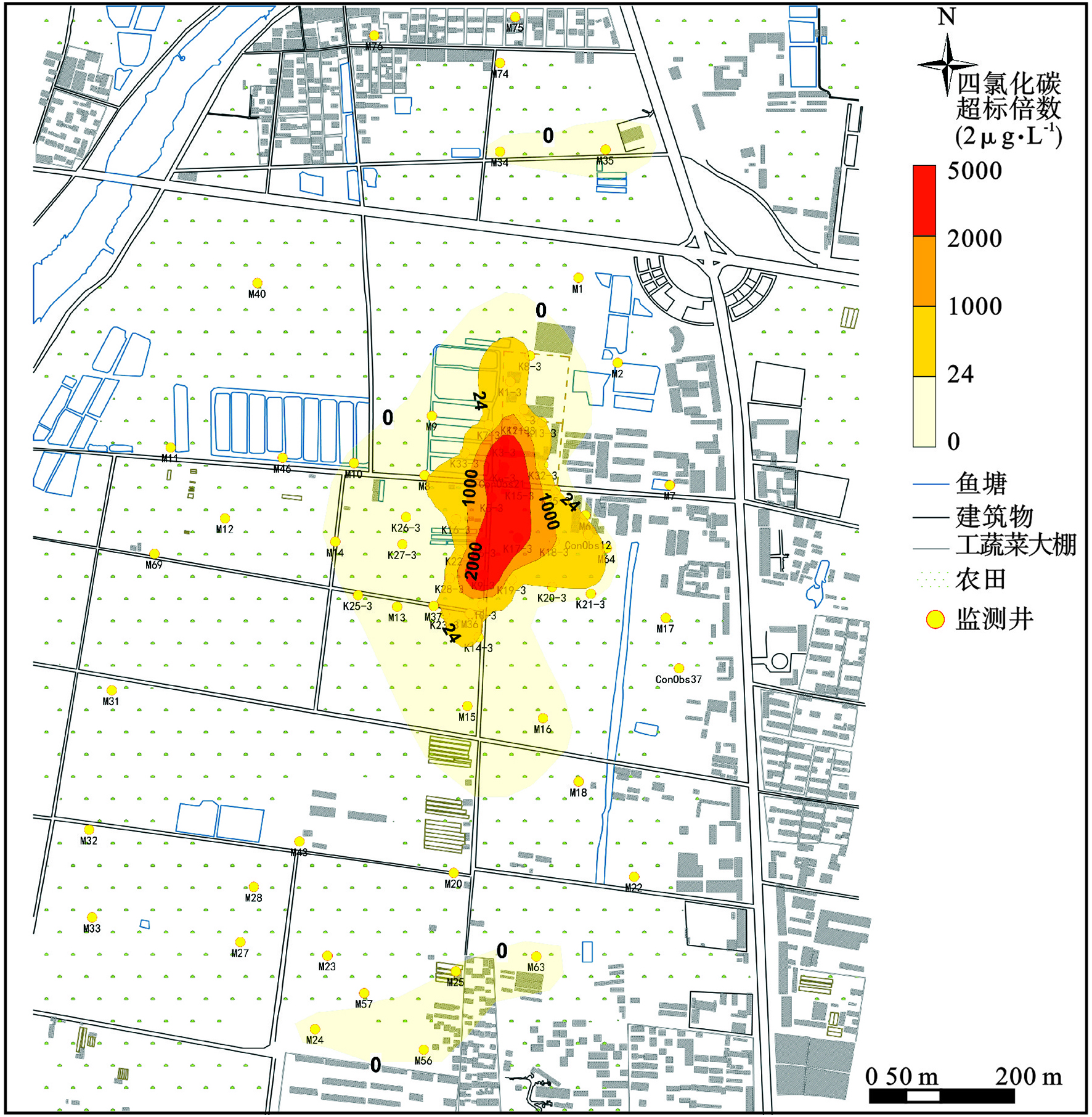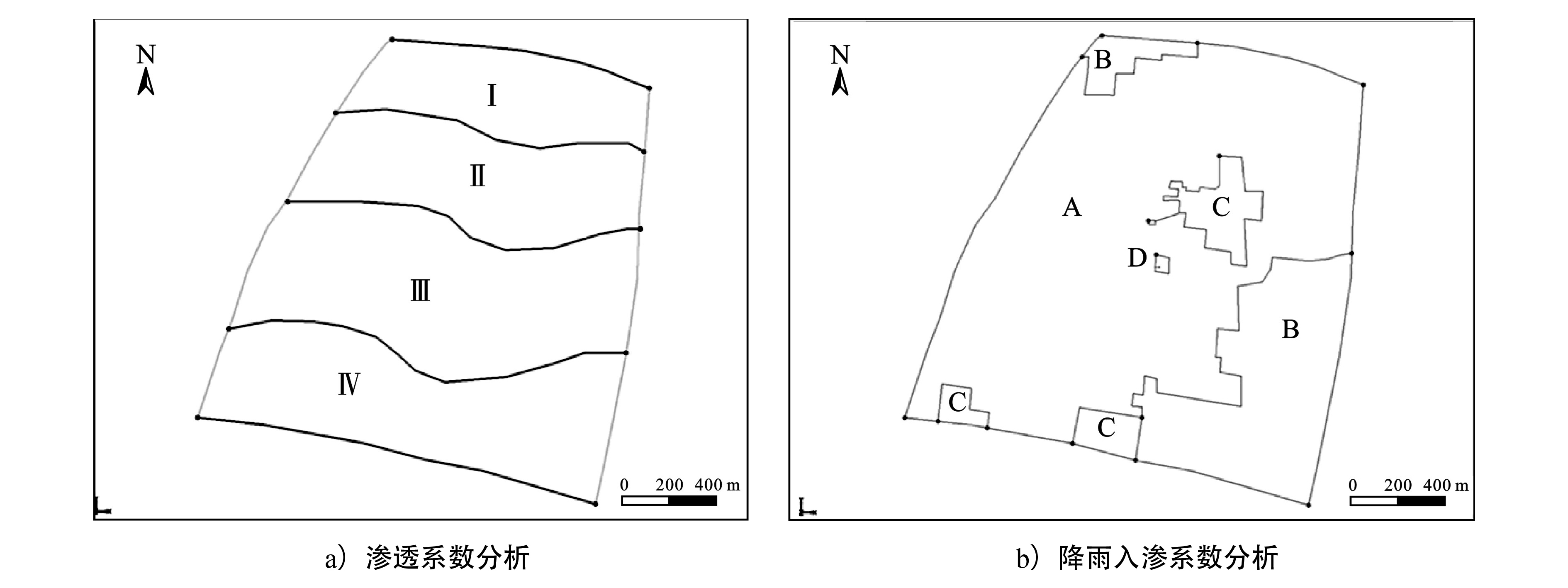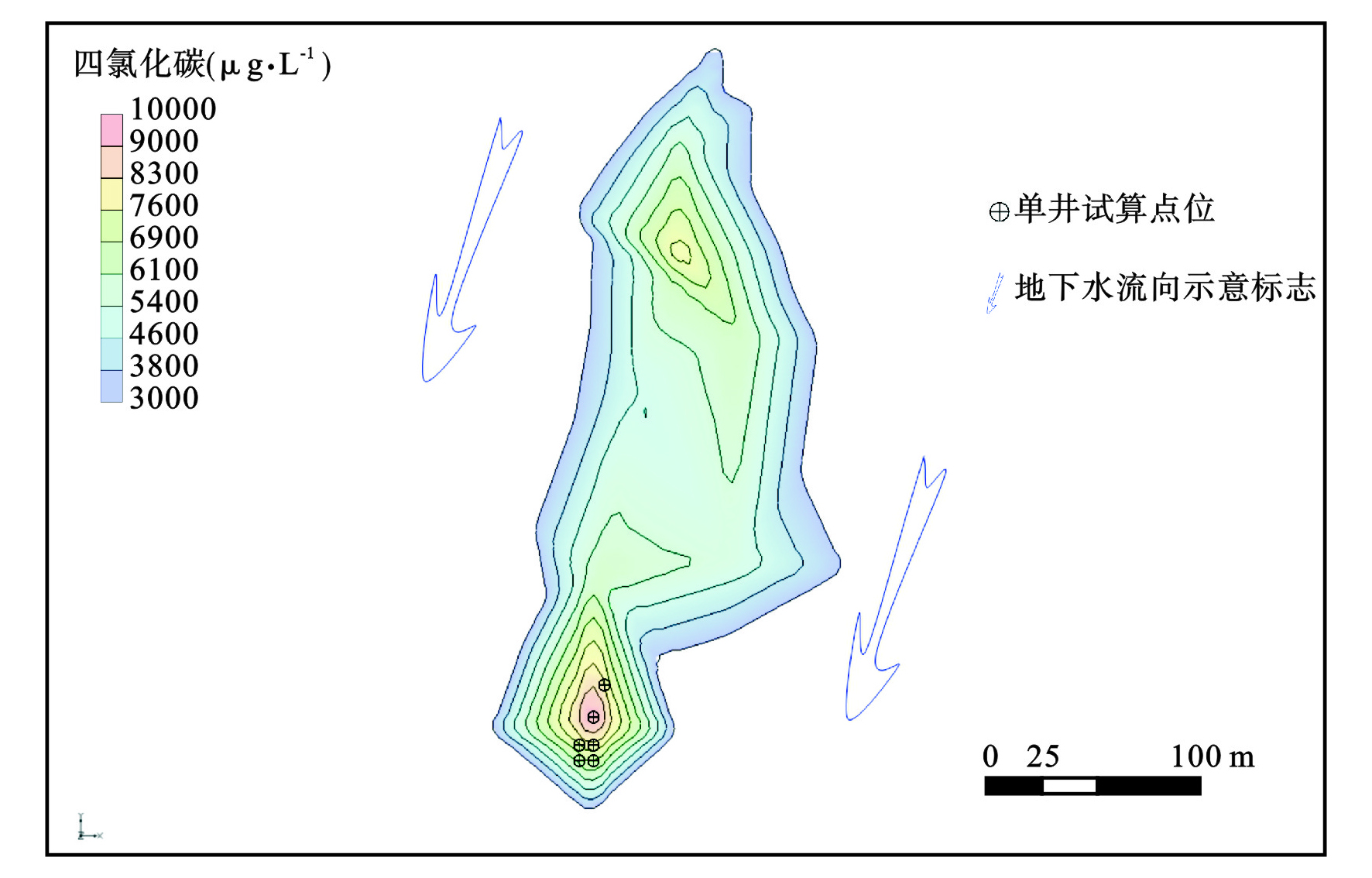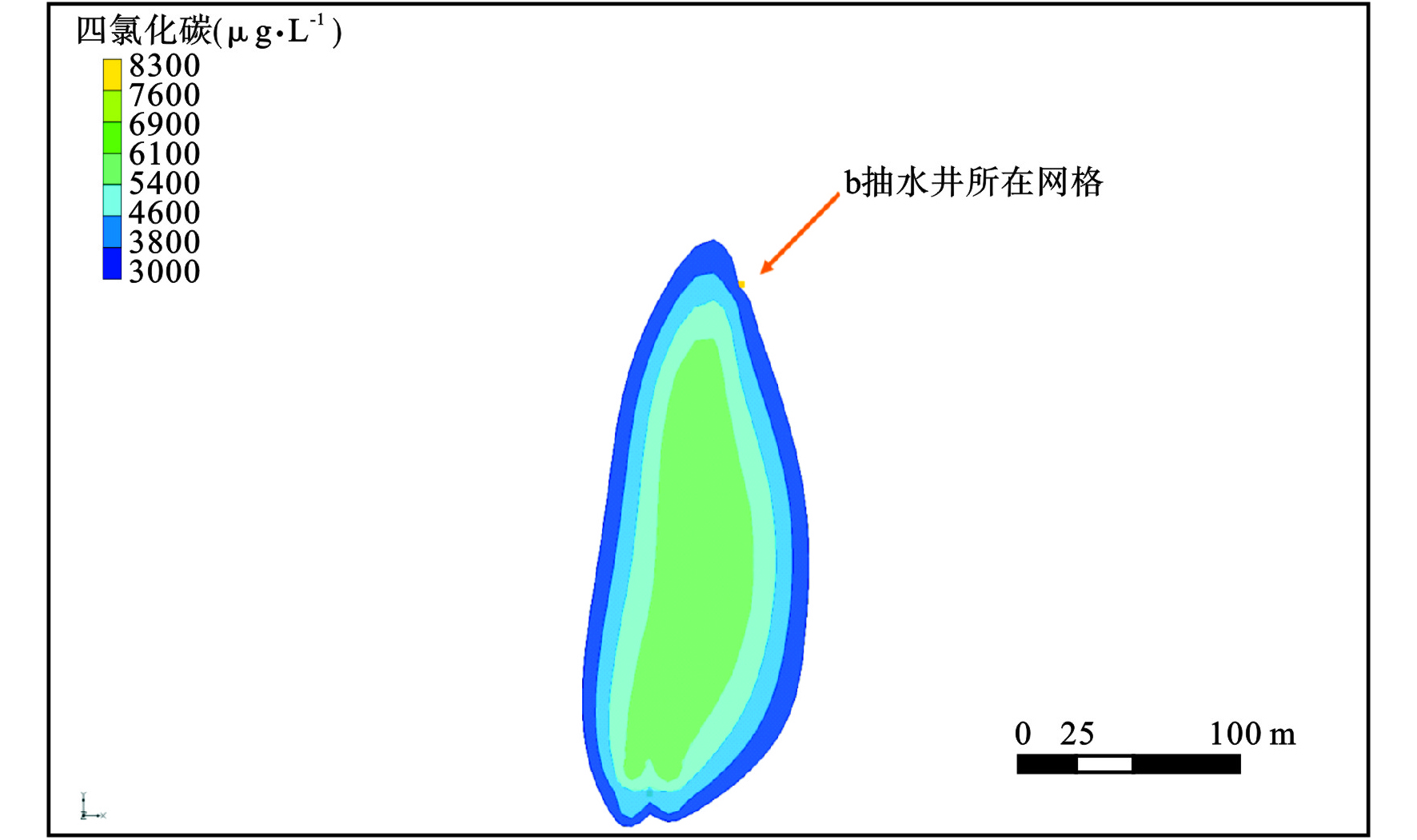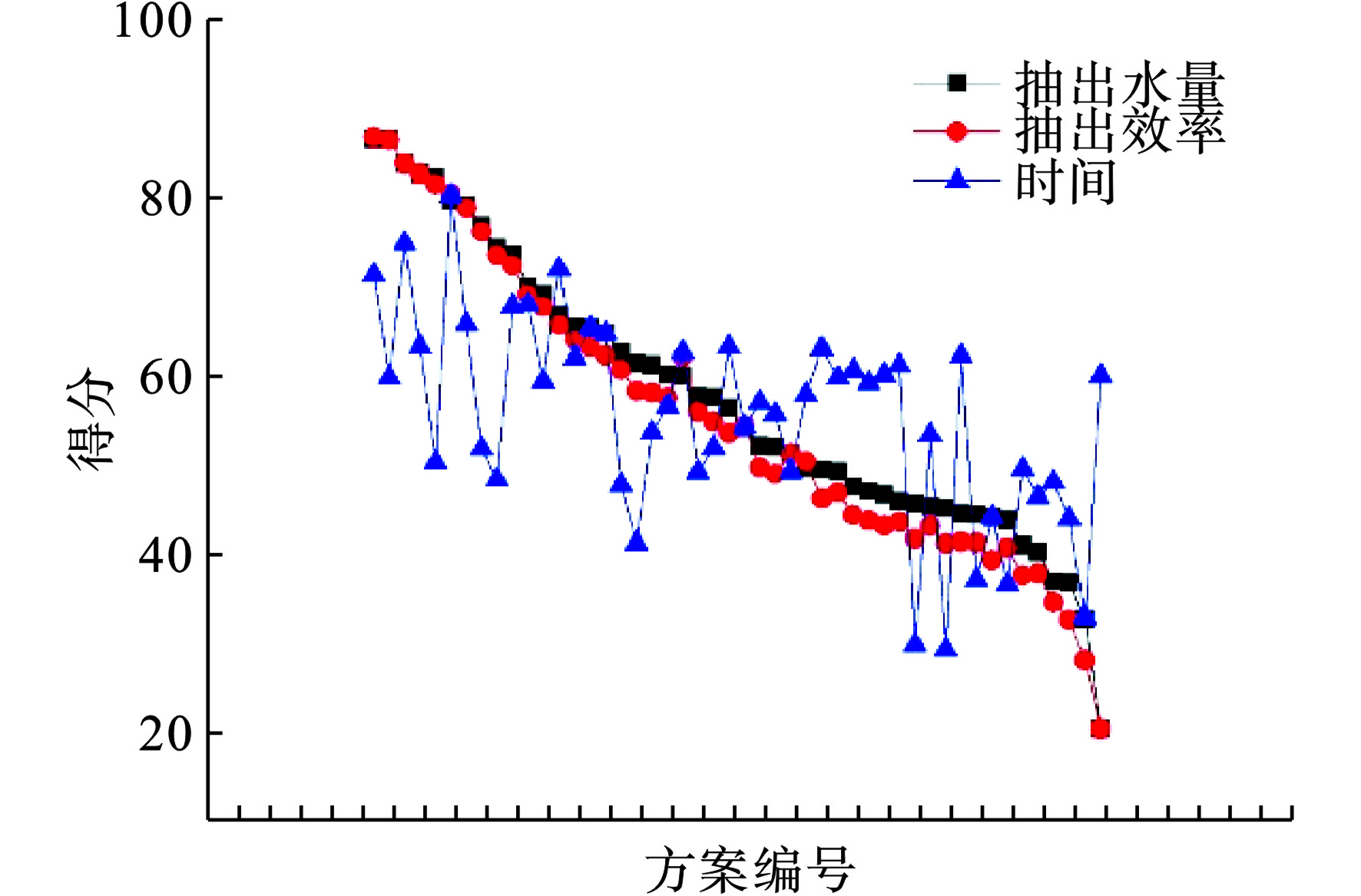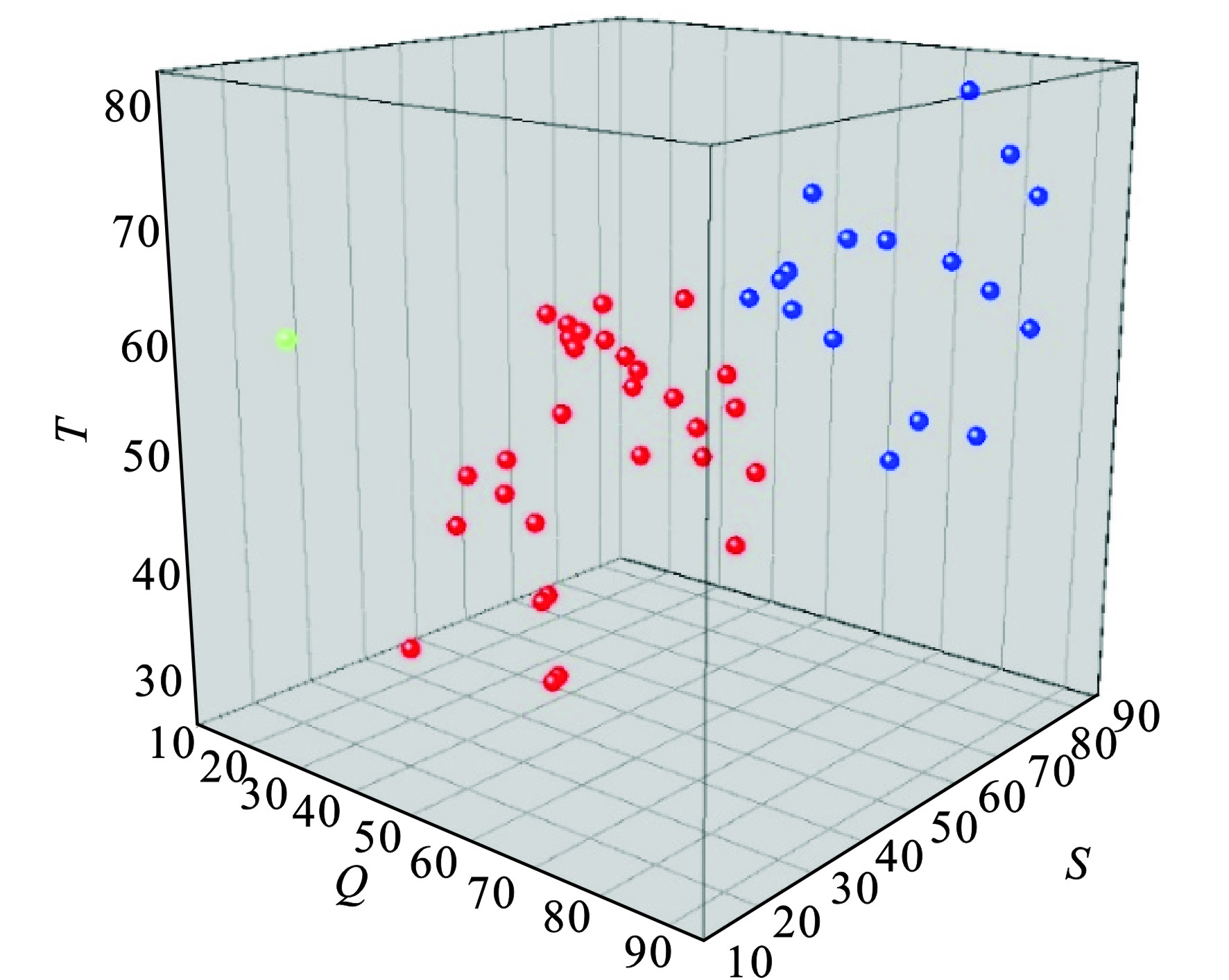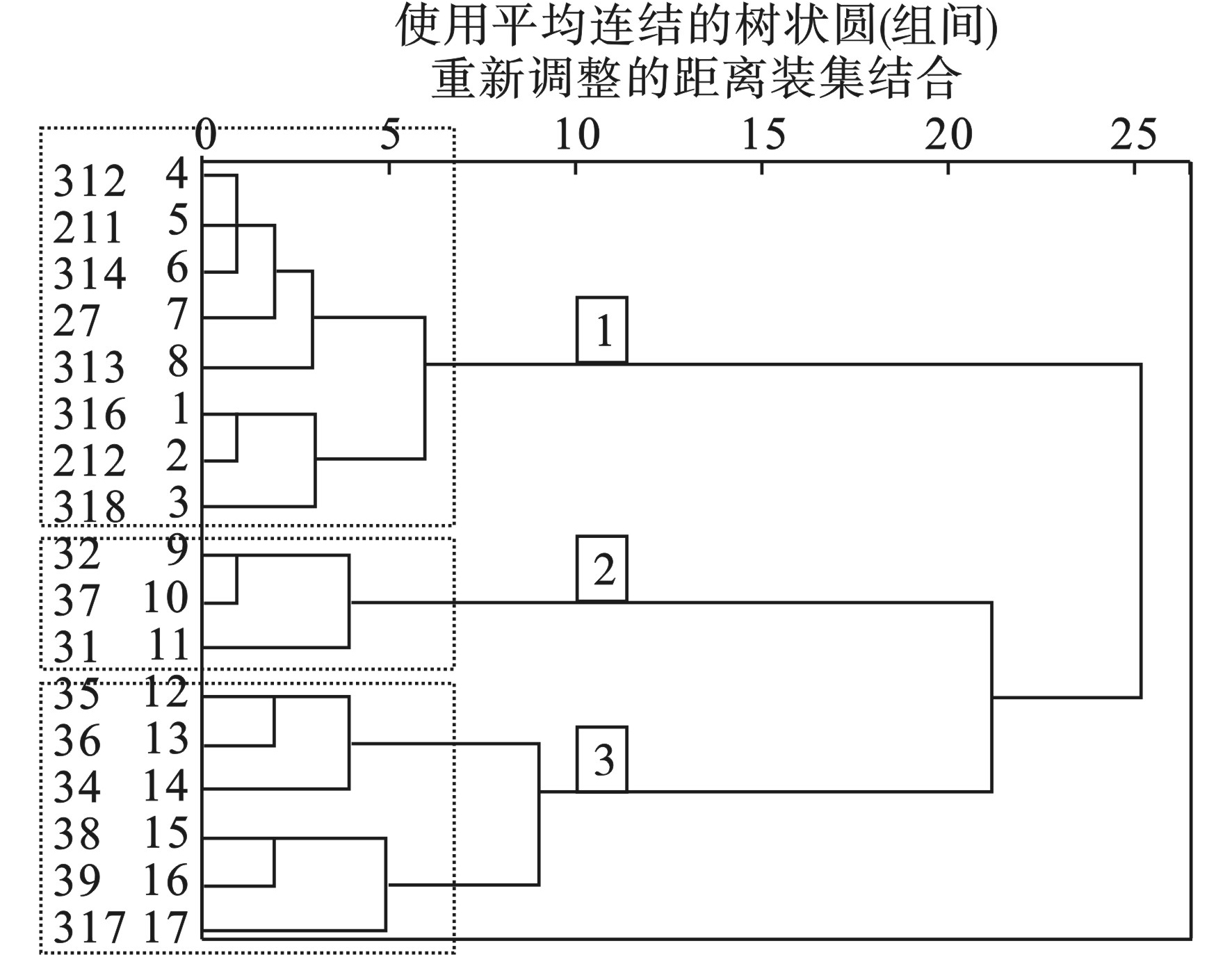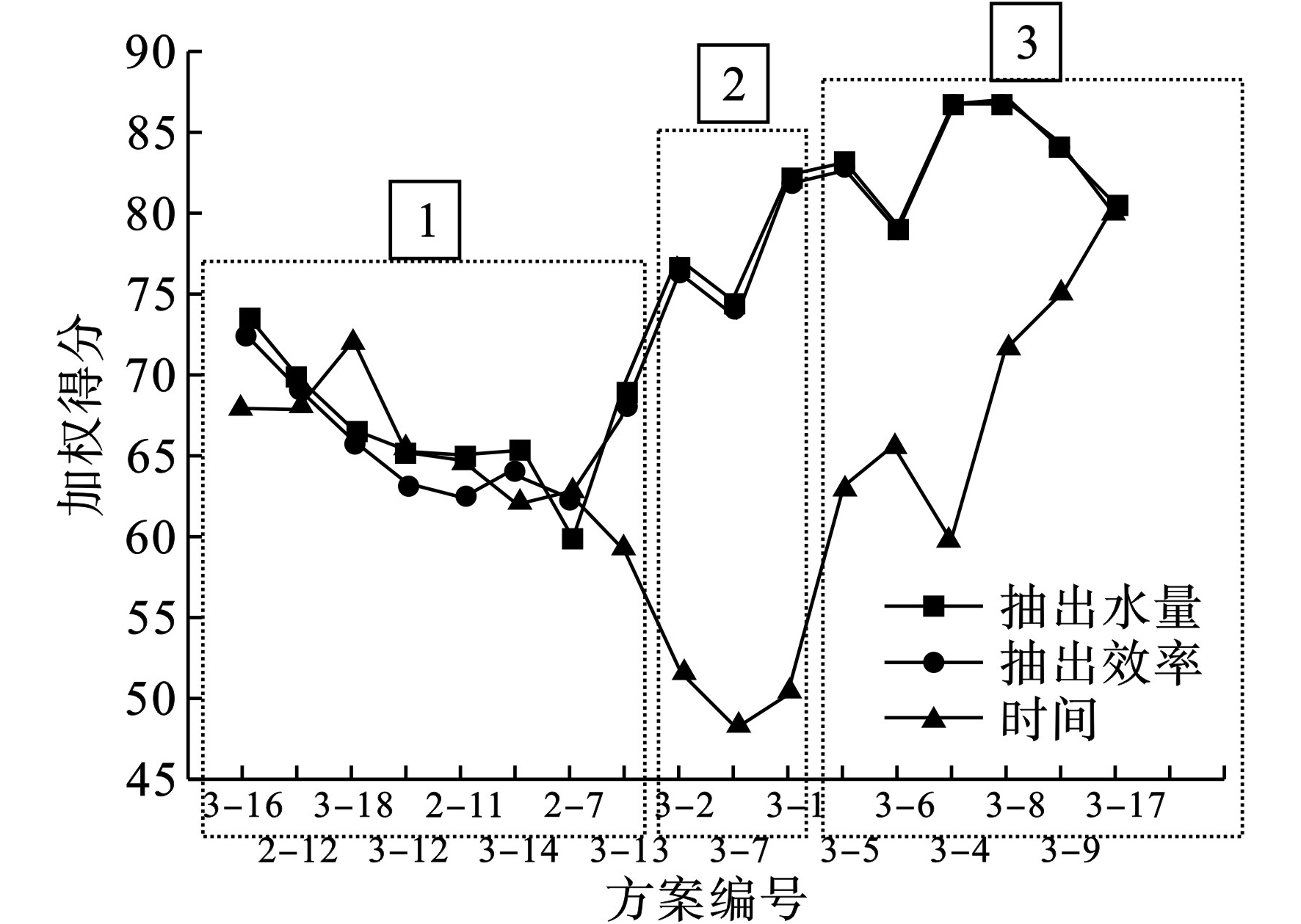-
近年我国地下水污染问题日益突出,随着相关的法规标准的不断出台,较多地下水污染防治项目亟待开展[1]。抽出-处理技术是处理污染地下水常用的修复和风险管控技术[2-5],美国在1982~1992年,78%的项目污染清除采用了抽出-处理技术[6]。氯代烃作为典型的有机污染物,难降解、易挥发、毒性大,是地下水中最难治理的污染物之一[7-8]。如何设计抽水方案中井数量、位置、抽水量等是目前研究的热点和难点。
国际研究者较早开始了抽水方案的设计研究[9-10],如DOUGHERTY假设稳定流求解多目标,将模拟退火法应用于抽水设计中[11]。MCKINNEY et al[12-13]分别采用改进遗传算法优化了目标函数,确定了抽水量、井位置, BECKER et al[14-15]均使用MGO(modular groundwater optimizer)和专家试算法对场地开展模拟与方案设计,节省5%~50%的成本,目前国内对于抽水方案的设计逐渐开始结合优化程序开展 [16-18],有较好应用前景,但需要技术人员有较强的编程基础,有一定普及难度。近年来随着地下水污染场地增多,国内研究者结合较丰富现场数据,通过专家试算法设计抽水方案的案例逐渐增多[19-21]。加权平均法也用来开展不同方案的评价与比选,但此前研究主要基于理想模型,没有结合实际场地开展讨论[22-23]。
本研究以氯代烃污染地下水场地为研究对象,基于详细调查结果绘制污染羽,借助GMS(Groundwater modeling system)建立数值模型,开展抽水方案设计,目标是消除浓度大于3 000 μg/L的污染羽,通过设定多因素多水平实验,试验稳定井流和非稳定井流,通过加权平均和聚类分析,确定最优方案。
-
研究区地势北高南低,年均降水量约919 mm。研究区上层为第四系松散岩类孔隙含水岩组,下层为基岩裂隙含水岩组,见图1。地下水流向与地表水一致,自北东向南西方向。
污染羽区域地下水有浇菜、洗衣等用途,污染羽下游1 km为该县城地下水水源。调查结果显示孔隙含水岩组的污染严重,人体健康风险不可接受,针对其污染共建设37口监测井,调查孔隙水民井104口,平均深度18.71 m。检测结果显示四氯化碳为风险最高的特征因子,监测井中51眼超标(2 μg/L),最大超标5 199倍[24-25],见图2。
-
该区域孔隙水流向呈北东-南西。根据多期实测流场设定模型边界,南、北边界平行于地下水流线,为定水头边界,水头值分别为34.5 m、30.09 m,模型南北距离2 733 m。南部边界至县城地下水水源保护区上边界。东西边界垂直于地下水流线,为零流量边界。
地层概化为3层:第①层:自地表至砂层中普遍发育的连续的粉质粘土层,平均厚度约5 m;第②层:孔隙水含水层平均厚度约10 m;第③层:普遍发育的粉质粘土,厚度2~3 m。
综上,将研究区地下水概化为二维非均质稳定流系统。考虑污染物在地下水中的对流、弥散、吸附和生物降解等,采用单一化学组分的二维迁移偏微分方程[26-27]。
-
依托概念模型,采用有限差分法建立数值模型,网格剖分为350行、400列、3层。根据实际钻孔揭露的地层高程插值形成网格顶板、底板。
查阅水文资料确定大气降水补给,通过不同区域的抽水试验,确定渗透系数分区,见图3。
结合钻孔揭露岩芯的情况确定给水度、孔隙度等。通过实测流场开展初始水位识别,设置拟合误差上限为0.3 m,结果显示误差满足95%置信区间,见图4。
溶质运移模拟的识别期为2012年10月~2017年6月,通过污染羽长度及浓度中心迁移距离完成识别,验证期为 2017年6月~2018年1月,通过两期浓度观测数据完成验证,见图5。设定参数区间,通过试错调参确定弥散度为10,吸附系数取0.000 008,生物降解系数取0.0005。
-
浓度大于3 000 μg/L的污染羽存在两个浓度中心,分别将下、上游浓度中心命名A高值区、B高值区。A、B高值区的浓度约10 000、8 000 μg/L,污染羽南北向展布,中部向东有扩散趋势,见图6。
-
对抽水方案实施效果影响较大的因素主要有抽出水量Q、时间T、井数量n等[16-17]。能否高效抽出高浓度污水是实际工程的重要考虑因素,故引入污染物截获效率S(kg/m3),见式(1)。
式(1)中,S为污染物截获效率,kg/m3;mass为累计抽出污染物总量,kg;Q为抽水量,m3。
-
抽水方案设计需要根据实际情况设定约束条件:设最大井数量为3口井,分别位于A、B高值区和东南部凸出位置,命名为a井、b井、c井;抽出时间不大于720 d;根据捕获区理论计算,单井抽出量不超过300 m3/d,根据水泵实际功率,不小于60 m3/d;Qa、Qb、Qc为3口井的流量大小,设定Qa>Qb,Qc;未能完全捕获目标污染羽,导致3 000 μg/L浓度污染羽向下游溢流的方案无效。
-
通过试错法,在6个井位中确定1个最优位置,命名为井a,见图7。将单井方案作为对照组开展模拟。
-
为了高效去除高浓度污染的地下水,b抽水井布设在B高值区下游。
若某浓度的污染羽没有完全被抽水井捕获继续向下游移动,此时该水井抽出的污染地下水浓度降低,截获效率也相应降低。为提高截获效率,模拟在合适的时刻关停上游低效率抽水井的情景,见图8。
观察b抽水井数值模型运行结果,可确定抽水浓度低于3 000 μg/L的时刻,需要在第132 d关停b抽水井,见图9。
基于模型运算结果,当a井流量小于260 m3/d时,将无法完全捕获目标污染羽。故对于a井考虑260、280和300 m3/d 3个流量梯度,b井流量考虑60、100、120和140 m3/d。a、b流量组合后模拟运行15例方案。
-
为了捕获范围更好地适应污染羽,第三口井布设于污染羽东南部凸出位置,命名为c抽水井。a、b、c三井联合抽出时,可形成图10所示捕获范围。根据单井抽水模拟结果,a井流量考虑180、220和260 m3/d三梯度;b井和c井的流量考虑60、100和140 m3/d 3梯度,设置全面实验,运行27例有效方案。
-
采用加权平均法,将总抽水量Q,达标时间T,截获效率S,井数量n作为决策变量,赋予不同的权重,见式(2)。
式(2)中,y1、y2、y3和y4分别为总抽水量Q(m3)、达标时间T(d)、截获效率S(kg/m3)和井数量n的基础得分。
基础得分的意义在于消除不同决策变量数值尺度及量纲差异。截获效率S的基础得分,见式(3)。
相反,总抽水量、达标时间和井数量的数值越高,成本越高,得分应越低,因此分数计算公式如下,以总抽水量Q(m3),见式(4)。
式(4)中,Qi是第i个方案的抽水总量;Qmax为最大抽水总量;Qmin为最小抽水总量设置3种不同的权重情景,情景1强调抽出水量,将经济因素作为最大权重考量;情景2强调截获效率,同时重视水量和出水浓度;情景3强调达标时间,表示项目性质为紧急响应事件,见表1。
-
3种情景加权方案中每个抽水方案的得分情况,见图11。
图11可知,侧重考虑抽出水量和截获效率的方案结果相关性较强,表明了由于井位布设合理,加上及时关停低效抽水井,抽水井始终可抽出较高浓度污水。
对48例方案得分进行系统聚类分析,采用欧式平方距离划定区间,组之间聚类方法将结果分为3类,见图12。
绿色点位是方案1~2,作为对照组采用了最大单井抽水量430 m3/d,获得了最短的达标时间440 d,但抽出水量比最小达标抽水量多了48%,抽水效率最低,可知单井大流量抽水虽可缩短达标时间,但会抽出大量低浓度污水,增加处理成本。30个红色点位方案平均得分48.3。17个蓝色点位方案平均得分70.9,能在满足要求的同时抽出较少水量。
进一步分析蓝点方案的聚类过程,可将17例方案分为1、2、3组,见图13。
1组在抽水效率、抽水量和时间3方面表现均衡,但平均得分不高;2组虽然抽水效率和抽水量得分较高,但达标时间较长;3组方案综合表现较优,进一步可看到3−8、3−9、3−17在抽水量、达标时间、抽出效率3方面都有较高分值,见图14。
方案3−8的抽水效率3.50 kg/m3优于17个优秀方案的平均值3.36 kg/m3,抽水效率提高4.14 %,抽水量13万m3比平均值13.9万m3减少5.85 %,达标时间501d比平均值507 d缩短1.1%;方案3−9分别为3.59%、2.65%和4.66%;方案3−17分别为−0.79%、1.19%和9.79%。可知3−17达标所用时间最短,3−9和3−8能更有效的节省水处理成本。对比对照组,3−8节省了48%的水处理成本。
-
(1)基于场地实际钻孔数据揭露的地层信息、实际检测数据完成数值模型的构建,初始水位拟合误差满足95%置信区间,验证模拟的污染羽长度、浓度分布基本实际情况,表明模型设置合理,模拟结果可信。
(2)采用单井抽水量430 m3/d作为对照组,在440 d达到设定修复标准。基于地下水污染分布及迁移趋势分析,在1、2、3眼井数量下运行48例抽水方案,调整井流量以及关停上游抽水井开展模拟,通过加权平均和聚类分析,筛选出17例较优方案集合,其中方案3−8建设3眼抽水井,分别以180、140和100 m3/d的流量抽水,在第135和219 d分别关停上游抽水井,达标时间501 d,比对照组节省48 %的水处理成本。
(3)单井抽出时为使捕获范围满足不规则形状的污染羽,需要增大抽水量,导致低浓度污水被抽出,增加项目成本;多井抽水可灵活调整井流量设计合理捕获范围,在适当时间关停上游抽水井,可提高截获效率,节省项目成本。
(4)加权平均的比选方法操作简明,可适应不同的优化需求;聚类分析在筛选分析最优方案上有较好的应用;若开展场地试验进一步识别和验证模型关键参数,可增加数值模拟预测结果的可信度;随着地下水在线监测系统和大数据分析技术的发展,结合本研究的技术方法,实时调整井群抽水量,使捕获范围持续适应污染羽变化,可达到更好的抽出效果。
基于数值模拟的某地下水污染场地抽水方案设计
Design of pumping project for a groundwater contaminated site based on numerical simulation
-
摘要: 为指导山东某氯代烃地下水污染场地开展地下水修复风险管控,建立了单层非均质二维地下水流模型和溶质运移模型,通过实测数据完成了模型的识别与验证。基于修复浓度大于3 000 μg/L污染物的目标,讨论48例不同井数量、不同抽水量的抽水方案,通过加权平均评价和聚类分析确定了响应不同性质事件的最优方案。结果表明:方案3~8在较短时间501 d达到设定修复标准,比对照组节省成本48%。实验验证了关停上游低效率抽水井、合理设计不同井位抽水量可提高截获效率,为类似污染场地地下水抽水方案设计提供了参考依据。Abstract: In order to guide the groundwater remediation and the risk control in a certain chlorinated hydrocarbon groundwater contaminated site in Shandong province, a monolayer heterogeneous two-dimensional groundwater flow model and a solute transport model were established. The identification and verification of the model were completed with the measured data. In order to repair the plume with a concentration of more than 3000 μg/L, 48 pumping projects with different number of wells and different amount of water were analyzed. The optimal project under different situations was determined by weighted average and cluster analysis. The results showed that the repair standard could be accomplished within 501 days by plan 3 to 8 by saving 48% of the cost comparing with the control group. The experiment verified that it could improve the interception efficiency by closing the low-efficiency pumping wells upstream and rationally designing the pumping water at different well locations, thus providing a reference for the design of pumping projects in similar polluted sites.
-

-
表 1 加权方案
决策变量 加权方案1
(抽出水量)加权方案2
(截获效率)加权方案3
(达标时间)抽出水量 0.50 0.30 0.20 时间 0.15 0.15 0.50 截获效率 0.30 0.50 0.20 井数量 0.05 0.05 0.10 -
[1] 陈坚. 推进土壤与地下水污染协同防治[N]. 中国环境报, 2018-12-13(5). [2] 姜烈, 何江涛, 姜永海, 等. 地下水硝酸盐污染抽出处理优化方法模拟研究[J]. 环境科学, 2014, 35(7): 2572 − 2578. [3] 刘永娟, 韩宝平, 王小英. 地下水四氯化碳污染现状与治理技术研究进展[J]. 水资源保护, 2005(2): 5 − 8. [4] 蒲敏. 污染场地地下水抽出处理技术研究[J]. 环境工程, 2017, 35(4): 6 − 10. [5] MICHAEL R, OVADIA L, HAIM G. Optimal remediation scheme for a wastewater recharge site: contaminants fate and transport model[J]. Ground Water, 2018, 56(6): 801 − 880. [6] BROCKMAN F J, PAYNE W, WORKMAN D J, et al. Effect of gaseous nitrogen and phosphorus injection on in situ bioremediation of a trichloroethylene-contaminated site[J]. Journal of Hazardous Materials, 1995(2-3): 287 − 298. [7] 陆强. 上海某典型行业土壤和地下水中氯代烃的迁移转化规律及毒性效应研究[D]. 上海: 华东理工大学, 2016. [8] 丁一凡, 郝光, 刘本华, 等. 某四氯化碳污染场地自然恢复的地球化学特征[J]. 吉大学学报(地球科学版), 2018, 48(5): 1465 − 1472. [9] AHLFELD D P, MULVEY J M, PINDER G F, et al. Contaminated groundwater remediation design using simulation, optimization, and sensitivity theory, 1. Model development[J]. Water Resources Research, 1988, 3(24): 431 − 441. [10] GORELICK S M. Groundwater contamination: optimal capture and containment.[J]. Boca Raton Lewis Publishers, 1993, 88(5): 1012 − 1017. [11] DOUGHERTY D E, MARRYOTT R A. Optimal groundwater management: 1. simulated annealing[J]. Water Resources Research, 1991, 10(27): 2493 − 2508. [12] MCKINNEY D C, LIN M D. Approximate mixted-integer nonlinear programming methods for optimal aquifer remediation design[J]. International Journal of Rock Mechanics and Mining Sciences and Geomechanics Abstracts, 1996, 33(2): 731 − 740. [13] PARK C H, ARAL M M. Multi-objective optimization of pumping rates and well placement in coastal aquifers[J]. Journal of Hydrology, 2004, 290(1): 80 − 99. [14] BECKER D, MINSKER B, GREENWALD R, et a. Reducing long-term remedial costs by transport modeling optimization[J]. Ground Water, 2006, 6(44): 864 − 875. [15] SINGH T S, CHAKRABARTY D. Multiobjective optimization of pump-and-treat-based optimal multilayer aquifer remediation design with flexible remediation time[J]. Journal of Hydrologic Engineering, 2011, 5(16): 413 − 420. [16] 刘苑. 地下水污染区抽水井优化研究[D]. 北京: 清华大学, 2008. [17] 万鹏. 污染地下水抽出—处理技术的抽水方案优化研究[D]. 北京: 清华大学, 2013. [18] 万鹏, 张旭, 李广贺, 等. 基于模拟-优化模型的某场地污染地下水抽水方案设计[J]. 环境科学研究, 2016(29): 1608 − 1616. [19] 宫志强, 陈坚, 刘明柱, 等. 单井捕获地下水污染羽的优化方法[J]. 环境工程学报, 2019, 13(10): 2468 − 2474. [20] 宫志强, 陈坚, 杨鑫鑫, 等. 某铬污染场地地下水抽水方案优化[J]. 环境工程, 2019, 37(5): 4 − 6. [21] 王平, 韩占涛, 张海领, 等. 某氨氮污染地下水抽出-处理系统优化模拟研究[J]. 水文地质工程地质, 2020, 47(3): 34 − 43. [22] 张艳. 污染场地抽出—处理技术影响因素及优化方案研究[D]. 北京: 中国地质大学(北京), 2010. [23] 鞠晓明. 地下水污染场地水力控制优化方案研究[D]. 北京: 中国地质大学(北京), 2011. [24] 刘伟江, 陈坚, 刘锐, 等. 郯城某化工厂周边地下水污染现状调查与评价[J]. 安全与环境工程, 2018, 25(6): 67 − 75. [25] LIU W J, CHEN L Z, LIU X, et al. Comparison of the health risks associated with different exposure pathways of multiple volatile chlorinated hydrocarbons incontaminated drinking groundwater[J]. Environmental Pollution, 2019, 255: 113339. [26] 薛禹群, 朱学愚, 吴吉春, 等. 地下水动力学[M]. 北京: 地质出版社, 1986. [27] 郑春苗, 贝聂特. 地下水污染物迁移模拟[M]. 北京: 高等教育出版社, 2009. -



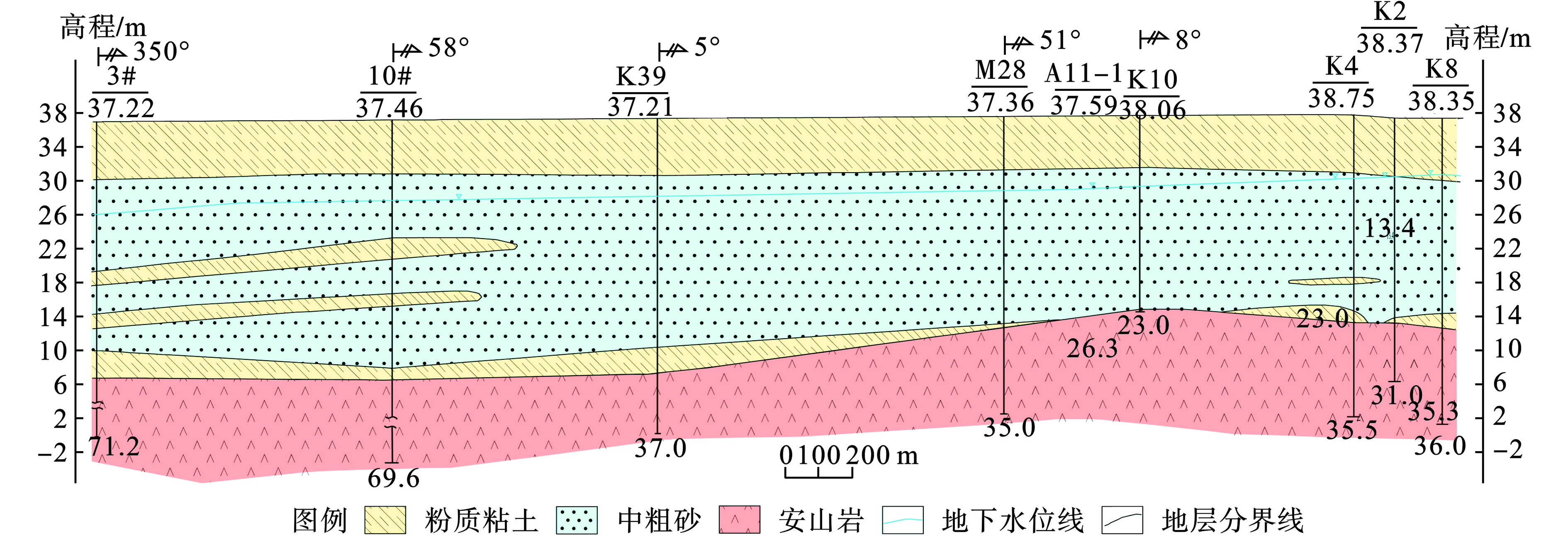
 下载:
下载:
